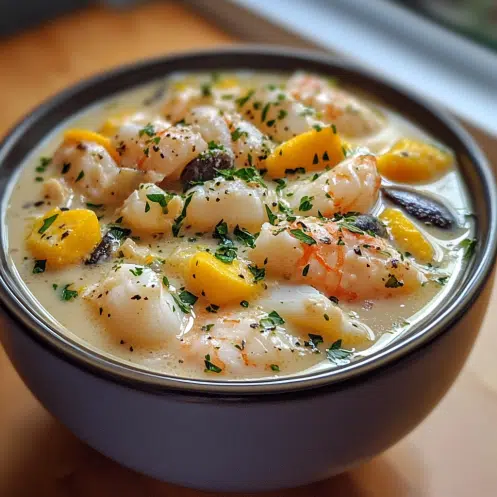Introduction:
Dive into the ultimate Seafood Chowder recipe that’s both comforting and luxurious. This creamy, flavorful chowder blends a variety of fresh seafood with a rich, savory broth, making it the perfect choice for any occasion. Whether you’re preparing a cozy dinner or a special gathering, this Seafood Chowder is sure to impress.
Ingredients:
- 1 lb shrimp, peeled and deveined
- 1 lb crab meat
- 1 lb white fish fillets, diced
- 4 cups seafood stock
- 2 cups heavy cream
- 4 slices bacon, chopped
- 1 medium onion, diced
- 2 cloves garlic, minced
- 3 medium potatoes, peeled and cubed
- 1 cup corn kernels
- 2 tbsp flour
- 2 tbsp butter
- Salt and pepper to taste
- Fresh parsley for garnish
Instructions:
- In a large pot, cook bacon over medium heat until crisp. Remove bacon and set aside.
- In the same pot, sauté onion and garlic in bacon fat until translucent.
- Stir in flour and cook for 1 minute, then add seafood stock and bring to a simmer.
- Add potatoes and cook until tender, about 10 minutes.
- Stir in heavy cream, then add shrimp, crab, and fish. Simmer until seafood is cooked through.
- Mix in corn, butter, and cooked bacon. Season with salt and pepper.
- Garnish with fresh parsley before serving.
Serving and Storage Tips for Seafood Chowder:
Serving Tips:
- Garnish: Enhance the presentation of your Seafood Chowder with a sprinkle of fresh parsley or chives. A dash of paprika or a drizzle of cream can also add a beautiful touch.
- Accompaniments: Serve your chowder with crusty bread, garlic toast, or oyster crackers to complement the creamy texture and soak up the delicious broth.
- Temperature: Seafood Chowder is best enjoyed hot. Ladle it into bowls and ensure it’s heated thoroughly before serving to maintain the creamy consistency and rich flavors.
- Portion Control: For a more substantial meal, consider serving the chowder in larger bowls. For lighter fare or as part of a multi-course meal, smaller portions or even in cups can be ideal.
Storage Tips:
- Refrigeration: Store leftover Seafood Chowder in an airtight container in the refrigerator. It will keep well for 3 to 4 days. Make sure to cool the chowder to room temperature before transferring it to the fridge to avoid condensation and spoilage.
- Freezing: While Seafood Chowder can be frozen, the texture of the seafood may change once thawed. To freeze, place the chowder in a freezer-safe container and leave space at the top for expansion. It can be frozen for up to 3 months.
- Reheating: Reheat leftover chowder gently on the stovetop over medium heat, stirring occasionally. Avoid boiling, as this can cause the seafood to become tough and the cream to separate. If reheating from frozen, thaw it in the refrigerator overnight before warming.
- Avoid Over-Storing: For best results, try to store only the amount of chowder you expect to use in one meal. Repeated reheating can affect the texture and flavor of the seafood.
Variations for Seafood Chowder:
- New England Style Chowder:
- Ingredients: Use clams instead of crab and fish. Add diced celery and carrots for additional texture.
- Seasoning: Season with thyme and a bay leaf for classic New England flavor.
- Southwestern Seafood Chowder:
- Ingredients: Incorporate ingredients like diced green chilies, corn, and black beans. Use a mix of shrimp, crab, and white fish.
- Seasoning: Add cumin, paprika, and a dash of cayenne pepper for a spicy kick. Garnish with fresh cilantro.
- Spicy Seafood Chowder:
- Ingredients: Include spicy sausage or chorizo along with shrimp, crab, and fish.
- Seasoning: Use red pepper flakes, hot sauce, or jalapeños to add heat. Adjust seasoning to taste.
- Asian-Inspired Seafood Chowder:
- Ingredients: Replace heavy cream with coconut milk for a lighter, Asian-inspired twist. Add sliced mushrooms and bok choy.
- Seasoning: Incorporate soy sauce, ginger, and garlic. Garnish with sliced scallions and a sprinkle of sesame seeds.
- Creamy Tomato Seafood Chowder:
- Ingredients: Add a cup of tomato sauce or diced tomatoes to the chowder base.
- Seasoning: Season with basil and oregano to complement the tomato flavor. This variation gives a slight tomato tang to the creamy base.
- Vegetarian Seafood Chowder:
- Ingredients: Replace seafood with plant-based seafood alternatives or extra vegetables like zucchini, bell peppers, and mushrooms. Use vegetable broth instead of seafood stock.
- Seasoning: Adjust seasoning with smoked paprika to mimic the depth of flavor typically provided by seafood.
- Lobster Seafood Chowder:
- Ingredients: Substitute lobster meat for crab, and add a splash of sherry for extra richness.
- Seasoning: Enhance with a touch of lemon zest and a sprinkle of Old Bay seasoning for a touch of elegance.
- Low-Carb Seafood Chowder:
- Ingredients: Replace potatoes with cauliflower florets for a lower-carb option.
- Seasoning: Add extra herbs and spices to enhance flavor, as cauliflower has a milder taste compared to potatoes.
- New England Style Chowder:
Conclusion:
This Seafood Chowder recipe is your ticket to a delicious, satisfying meal that’s both easy to make and rich in flavor. With its blend of fresh seafood and creamy goodness, it’s the ultimate comfort dish for any seafood lover. Enjoy the perfect balance of textures and tastes with each hearty spoonful.

